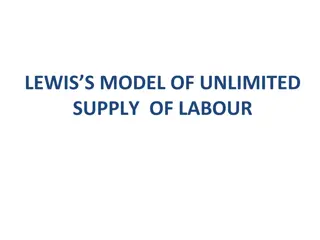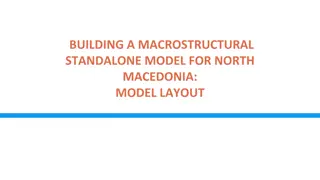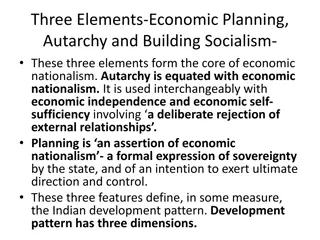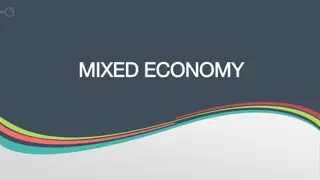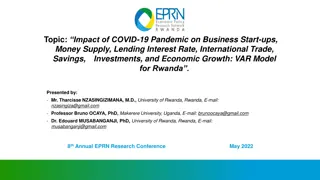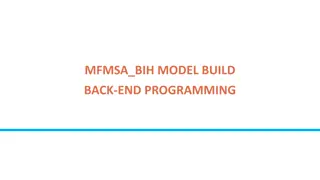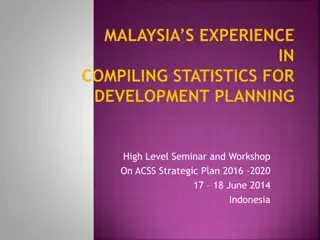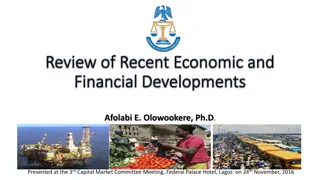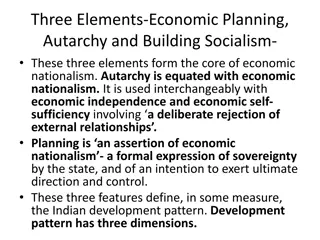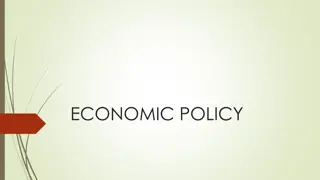Polak Model and Working: Understanding Economic Influences
Polak model examines the impact of elements like net domestic loans, money supply, GDP, net foreign claims, and more on economic growth and inflation. By analyzing factors like budget deficits, loan demands, and foreign indebtedness, it uncovers how changes in loan demand and other variables affect key economic indicators. Exogenous factors, such as export competitiveness and investment climate, also play a crucial role in shaping economic outcomes.
Uploaded on Feb 20, 2025 | 1 Views
Download Presentation

Please find below an Image/Link to download the presentation.
The content on the website is provided AS IS for your information and personal use only. It may not be sold, licensed, or shared on other websites without obtaining consent from the author.If you encounter any issues during the download, it is possible that the publisher has removed the file from their server.
You are allowed to download the files provided on this website for personal or commercial use, subject to the condition that they are used lawfully. All files are the property of their respective owners.
The content on the website is provided AS IS for your information and personal use only. It may not be sold, licensed, or shared on other websites without obtaining consent from the author.
E N D
Presentation Transcript
Polak modell A NDL + X M3 + + + NFY+NT + NFC GDP - + M
Meanings of abbreviations NDL change in net domestic loan M3 change in money supply M3 (cash + deposit in sight and short term deposit) GDP Gros Domestic Product M import NFC change in net foreign claims NFY net factor yield NT net transfer X export
Extended version of Polak model + S/D NBL CHL B + A + - Pr Ac NDL + In real_GDP X + M3 + + + + + = NFY+NT NFC nom_GDP P*real_GDP + - + CAB M NMT C l
Meanings of new abbreviations NBL change in net budget loans CHL change in corporate/households loan B change in long term bank liabilities CAB current account balance S/D budget surplus/deficit P price level In inflation real_GDP economic growth Pr change in productivity Ac change in activity
Working of model Budget deficit and loan demand of corporates and households increase the net domestic loan. Its increase enhances the money supply, which leads greater income. The greater income is spent in three way. The income leads to greater real GDP growth or/and leads to higher inflation or/and leads to bigger import. The import decreases the net foreign claims, so it leads to foreign indebtedness. The influancing factors are the followings: Demand flexibility of import Flexibility of production factors Inflation expectations Exchange rates and interest rates
Elements of net foreign claims CAB current account balance X - export M - import NFY net factor yields NT net transfers NMT non monetary transfer (direct foreign investment)
Exogenious factors(adszorpci) They are independent from the monetary policy (structural factors) X export (depends on international competitiveness NFY net foreign yield (depends on ownership structure) NDL change in net domestic loan (depends on loan demand of state, corporates and households) NMT non monetary transfer (depends on investment climate
Polak-modell (2006/2011) S/D + -9,3%/+3,5% NBL +3%/+2% CHL +8%/-5% B 0%/+3% + A + - Pr Ac 0%/+2% NBH +11%/+2% +4%/-0,8% + In re l_GDP +4%/+1,2% X +3,9%/+4,1% M3 68%/75% + + 6%/2% + + + + NFC -2%/+9% NFY+NT -7%/-5%;0%/+4% = nom_GDP 23.755/28.189 P*re l_GDP + - + CAB M NMT +9%/-2% -11%/+7% 70%/65% Target


